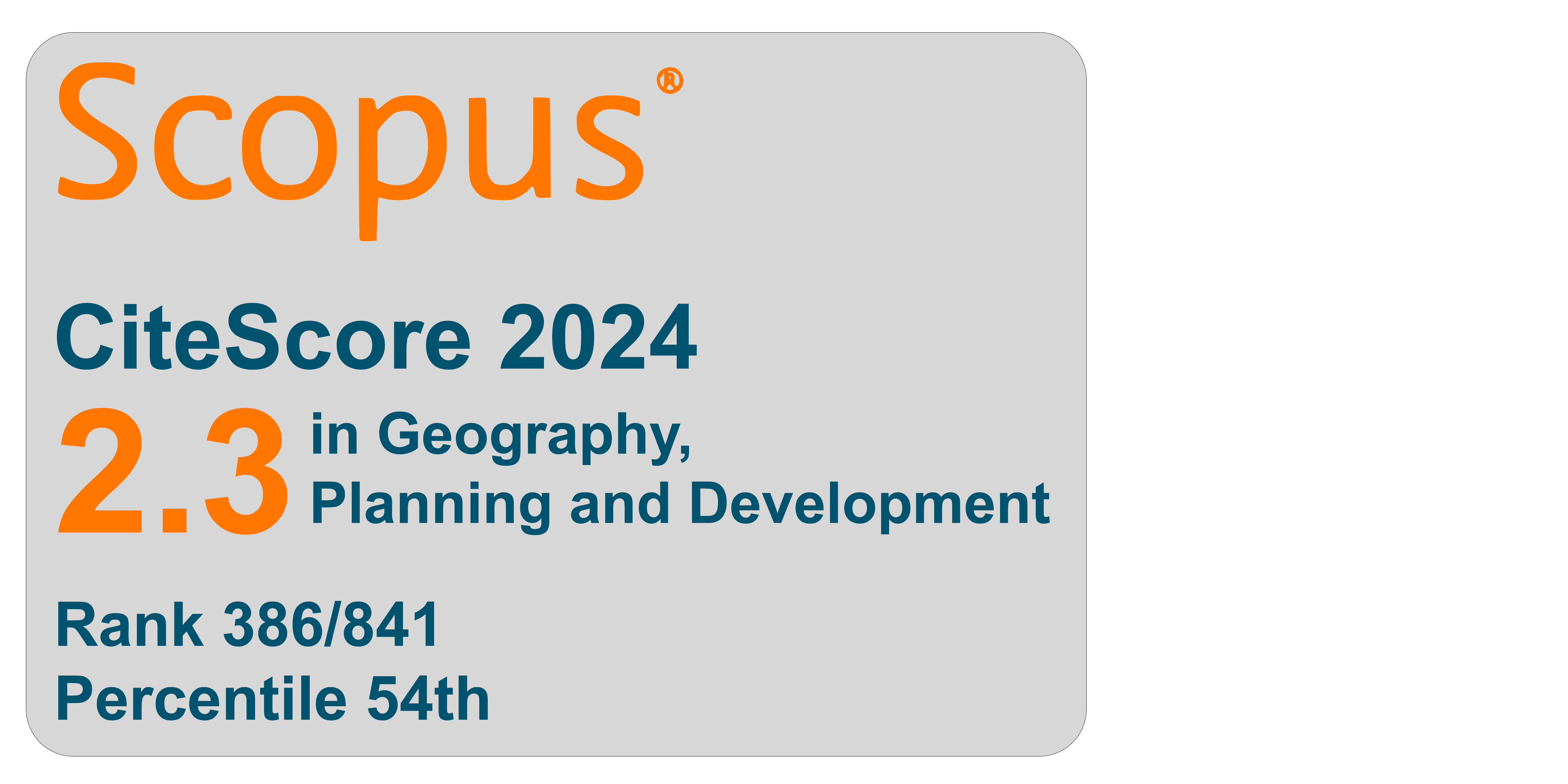Spatial-cognition ontology models in policymaking: dealing with urban landmarks in literary narratives
DOI:
https://doi.org/10.6093/1970-9870/10183Keywords:
Knowledge management, Decision dupport, Urban planning, Ontology, Literary WorksAbstract
Urban complexity is expressed through multiple and multiform directions and dimensions. With the aim of operationally managing such complexity, scholars have recently started uneasy research toward the construction of system architectures to support informed and aware policymaking. In particular, agent-based modelling efforts have been developed using the so-called applied ontologies. These models appear promising towards supporting complex relational and cognitive interactions in processes of urban decisions. Increasing simulation and experimentation activities are now oriented towards the support of ontology-based spatial planning processes in the real world. In the current planning context, where natural discourses and narrations are embedded in participatory plans, useful answers can also be provided by the narrations of some literary works, in the aforementioned sense. The work we have carried out explores the spatial representations included in those narratives, trying to develop ontological analyzes based on complex structuring characters and features of the represented urban spaces. The work is based on multi-agent experiments carried out with university students, who have extracted some passages from literary works dealing with urban environments. In particular, the paper analyzes some narratives focused on the urban square (or 'piazza'), with the aim of drawing out an ontology of it including aspects of literary semantics.
Downloads
References
Acierno, M., Cursi, S., Simeone, D., & Fiorani, D. (2017). Architectural heritage knowledge modelling: An ontology-based framework for conservation process. Journal of Cultural Heritage, 24, 124-133. https://doi.org/10.1016/j.culher.2016.11.007
Asim, M. N., Wasim, M., Khan, M. U. G., Mahmood, W., & Abbasi, H. M. (2018). A survey of ontology learning techniques and applications. Database, 2018, bay101. https://doi.org/10.1093/database/bay101
Biagetti, M. T. (2016). Un modello ontologico per l'integrazione delle informazioni del patrimonio culturale: CIDOC-CRM. Italian Journal of Library, Archives and Information Science, 7(3), 43-77. https://doi.org/10.4403/jlis.it-11649
Borges, J., Zyngier, C., Lourenço, K., & Santos, J. (2014). Spatial Perception and Cognition Review. Considering Geotechnologies as Urban Planning Strategy. TeMA - Journal of Land Use, Mobility and Environment. 97-108 https://doi.org/10.6092/1970-9870/2538
Borgo, S., & Masolo, C. (2010). Ontological foundations of DOLCE. In R. Poli, M. Healy, & A. Kameas (Eds.), Theory and applications of ontology: Computer applications (279-295). Cham: Springer. https://doi.org/10.1007/978-90-481-8847-5_13
Borgo, S., Borri, D., Camarda, D., & Stufano Melone, M. R. (2021). An ontological analysis of cities, smart cities and their components. In M. Nagenborg, T. Stone, M. González Woge, & P. E. Vermaas (Eds.), Technology and the City (365-387). Cham: Springer. https://doi.org/10.1007/978-3-030-61786-8_19
Borri, D., Camarda, D., & Pluchinotta, I. (2013). Planning urban microclimate through multiagent modelling: A cognitive mapping approach. Lecture Notes in Computer Science, 8091, 169-176. https://doi.org/10.1007/978-3-642-39649-6_14
Caglioni, M., & Rabino, G. A. (2007). Theoretical approach to urban ontology: A contribution from urban system analysis. In J. Teller, J. R. Lee, & C. Roussey (Eds.), Ontologies for Urban Development (109-119). Cham: Springer. https://doi.org/10.1007/978-3-540-71976-2_9
Campana, D. (1989). Canti Orfici e Altre Poesie. Milano: Garzanti.
Cantale, C., Cantone, D., Lupica Rinato, M., Nicolosi-Asmundo, M., Santamaria, D. F., & Stufano Melone, M. R. (2021). The ideal Benedictine monastery: From the Saint Gall map to ontologies. Applied Ontology, 16, 137-160. https://doi.org/10.3233/AO-210248
Cerdà, I. (1867). Teoria General de l'Urbanizacion. Madrid: Imprenta Espanola.
Cresswell, M. J. (1986). Why objects exist but events occur. Studia Logica, 45(4), 371-375. https://doi.org/10.1007/BF00372704
De Nicola, A., & Villani, M. L. (2021). Smart city ontologies and their applications: A systematic literature review. Sustainability, 13(10), 5578. https://doi.org/10.3390/su13105578
Dardi, C. (1987). Place d’Italie. Agora', 1.
Dodi, L. (1972). Città e Territorio: Urbanistica Tecnica. Milano: Masson.
Doerr, M. (2003). The CIDOC conceptual reference module: An ontological approach to semantic interoperability of metadata. AI Magazine, 24(3), 75-75. https://doi.org/10.1609/aimag.v24i3.1720
Falquet, G., Metral, C., Teller, J., & Tweed, C. (2011). Ontologies in Urban Development Projects. London: Springer. https://doi.org/10.1007/978-0-85729-724-2
Feraboli, M. T. (2007). Piazze. Milano: White Star.
Geertman, S., Ferreira, J., Goodspeed, R., & Stillwell, J. (2015). Planning Support Systems and Smart Cities. Berlin: Springer. https://doi.org/10.1007/978-3-319-18368-8
Goldstein, B. E., Wessells, A. T., Lejano, R., & Butler, W. (2015). Narrating resilience: Transforming urban systems through collaborative storytelling. Urban Studies, 52(7), 1285-1303. https://doi.org/10.1177/0042098013505653
Guarino, N., Gangemi, A., Masolo, C., Oltramari, A., & Schneider, L. (2002). Sweetening ontologies with DOLCE. In A. Gomez-Perez & V. R. Benjamins (Eds.), Knowledge Engineering and Knowledge Management: Ontologies and the Semantic Web (166-181). Berlin: Springer. https://doi.org/10.1007/3-540-45810-7_18
Guarino, N., Oberle, D., & Staab, S. (2009). What is an ontology? In S. Staab & R. Studer (Eds.), Handbook on Ontologies (1-17). Berlin: Springer. https://doi.org/10.1007/978-3-540-92673-3_0
Hofstadter, D. R. (1995). Fluid Concepts and Creative Analogies. New York: Basic Books.
Husain, M. F., Al-Khateeb, T., Alam, M., & Khan, L. (2011). Ontology based policy interoperability in geo-spatial domain. Computer Standards & Interfaces, 33(3), 214-219. https://doi.org/10.1016/j.csi.2010.10.002
Isaac, A., & Haslhofer, B. (2013). Europeana linked open data. Semantic Web, 4(3), 291-297. https://doi.org/10.3233/SW-2012-0073
Downloads
Published
How to Cite
Issue
Section
License
Copyright (c) 2024 TeMA - Journal of Land Use, Mobility and Environment

This work is licensed under a Creative Commons Attribution-NonCommercial 4.0 International License.



